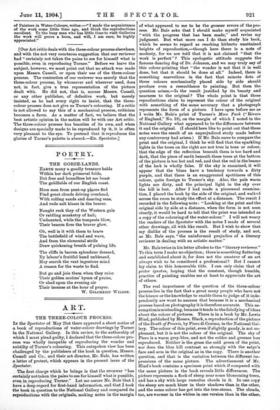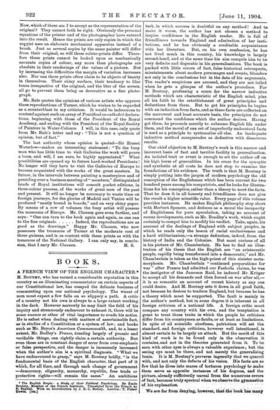ART.
THE THREE-COLOUR PROCESS.
IN the Spectator of May 21st there appeared a short notice of a book of reproductions of water-colour drawings by Turner in the National Gallery. In this review, to the authorship of which I must plead guilty, I declared that the three-colour pro- cess was wholly incapable of reproducing the wonder and subtilty of Turner's colouring. This outspoken view has been challenged by the publishers of the book in question, Messrs. Cassell and Co., and their art director, Mr. Bale, has written a letter of protest, which appears in the present issue of the Spectator.
The first charge which he brings is that the reviewer "has certainly not taken the pains to see for himself what is possible, even in reproducing Turner." Let me assure Mr. Bale that 1 have a deep regard for first-hand information, and that I took the book in question to the National Gallery and compared its reproductions with the originals, making notes in the margin
of what appeared to me to be the grosser errors of the pro- cess. Mr. Bale asks that I should make myself acquainted "with the progress that has been made," and revise my judgment. But what more can I do than study his book, which he seems to regard as reaching hitherto unattained heights of reproduction,—though here there is a note of modesty, for we are told that it is not claimed "that the work is perfect" ? This apologetic attitude suggests the famous dancing dog of Dr. Johnson, and we may truly say of this colour-printing that "the wonder is not that it is well done, but that it should be done at all." Indeed, there is something marvellous in the fact that minute dots of three colours mechanically placed side by side should produce even a resemblance to painting. But then the question arises,—Is the result justified by its beauty and nearness to the original ? The whole point is that these reproductions claim to represent the colour of the original with something of the same accuracy that a photograph represents the form of a picture. I have open before me as I write Mr. Bale's print of Turner's More Park (" Rivers of England," No. 18), on the margin of which I noted in the National Gallery what appeared to be the differences between it and the original. (I should here like to point out that these notes were the result of an unprejudiced study made before any controversy had arisen.) If Mr. Bale cares to compare the print and the original, I think he will find that the sparkling lights in the trees on the right are not true in tone or colour, that the edge of the reflection beneath them is too harel and dark, that the piece of earth beneath these trees at the bottom of the picture is too hot and red, and that the red in the beams of the lock is wholly false. If the sky is examined, it will appear that the blues have a tendency towards a dirty purple, and that there is an exaggerated spottiness of this colour, quite foreign to Turner's sky. Also, the pale warm lights are dirty, and the principal light in the sky over the hill is lost. After I had made a piecemeal examina- tion, I placed the book by the aide of the original, and walked across the room to study the effect at a distance. The result I recorded in the following note : "Looking at the print and the original side by side at a distance, when the form is not seen clearly, it would be hard to tell that the print was intended as a copy of the colouring of the water-colour." I will not weary the readers of the Spectator with the notes I made of several other drawings, all with like result. But I wish to show that my dislike of the process is the result of study, and not, as Mr. Bale says, "the uninformed prejudice of a literary reviewer in dealing with an artistic matter."
Mr. Bale twice in his letter alludes to the "literary reviewer." To this term I make no objection; there is something flattering and established about it, for does not the amateur of an art always wish to be considered a professional ? But I cannot lay claim to this honourable title. I can only claim that of pictor igriotus, hoping that the constant, though humble, practice of painting enables me at least to appreciate the art of others.
The real importance of the question of the three-colour process lies in the fact that a great many people who have not the leisure or the knowledge to enable them to judge of it inde- pendently are wont to assume that because it is a mechanical process based on photography it is therefore accurate. This as- sumption is misleading, because it tends to the falsifying of ideas about the colour of pictures. There is in a book by Mr. Lewis Hind, published by Messrs. Black, a reproduction of the picture of the Death of Procris, by Piero di Cosimo, in the National Gal- lery. The colour of this print, even if slightly gaudy, is not un- pleasant, but it is not the colour of the original. The sky of Piero is a warm grey-blue, and not the colder and greener hue reproduced. Neither is the grass the cold green of the print, nor does the blue hill contrast so strongly with the satyr's face and arm in the original as in the copy. There is another question, and that is the variation between the different im- pressions of the same picture. The advertisement of Mr. Hind's book contains a specimen print which if compared with the same picture in the book reveals little differences. The picture represents a flock of sheep near some blossoming trees, and has a sky with large cumulus clouds in it. In one copy the sheep are much bluer in their shadows than in the other, and the same colour has got into the tree-stems. The clouds, too, are warmer in the whites in one version than in the other.
Now, which of these am I to accept as the representation of the original ? They cannot both be right. Obviously the personal equations of the printer and of the photographer have entered into the result. Hence the prints are only copies in which the copyist uses an elaborate mechanical apparatus instead of a brush. Just as several copies by the same painter will differ from their original, so will these colour-prints differ. There- fore these prints cannot be looked upon as mechanically accurate copies of colour, any more than photographs are absolute in their renderings of the values of a picture. But by increasing the difficulties the margin of variation increases also. Nor can these prints often claim to be objects of beauty in themselves. Their shiny surface, their tendency to lilac tones irrespective of the original, and the blur of the screen, all go to prevent them being as decorative as a fine photo- graph.
Mr. Bale quotes the opinions of various artists who approve these reproductions of Turner, which he wishes to be regarded as a counterblast to my criticism. It would be indecorous to contend against such an array of Pontifical ex-cathecirci declara- tions, beginning with those of the President of the Royal Academy, and ending with the President of the Royal Society of Painters in Water-Colours. I will, in this case, only quote from Mr. Bale's letter and say : "This is not a question of opinion, but of fact."
The last authority whose opinion is quoted—Sir Ernest Waterlow—makes an interesting statement; "To the busy man who has little time to visit Galleries the work will prove a boon, and will, I am sure, be highly appreciated." What possibilities are opened up to future hard-worked Presidents ! No longer will they have to visit the Galleries of Europe to become acquainted with the works of the great masters. In future, in the intervals between painting a masterpiece and of presiding over a business meeting of" members," distinguished heads of Royal institutions will consult pocket editions, in three-colour process, of the works of great men of the past and present. It will no longer be necessary to waste time on foreign journeys, for the glories of Madrid and Venice will be produced "neatly bound in boards," and on very shiny paper. By means of a row of volumes the busy artist will possess the museums of Europe. Mr. Clausen goes even further, and says : "One can turn to the book again and again, as one can to the fine originals Indeed, the reproductions are as good as the drawings." Happy Mr. Clausen, who now possesses the treasures of Turner at the moderate cost of three guineas, and is as content with these prints as with the treasures of the National Gallery. I can only say, in conclu-











































 Previous page
Previous page